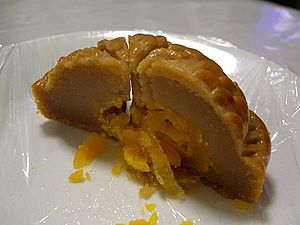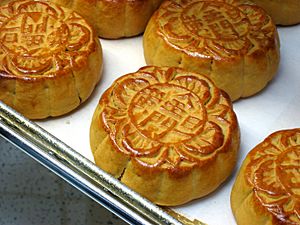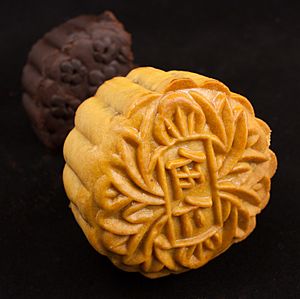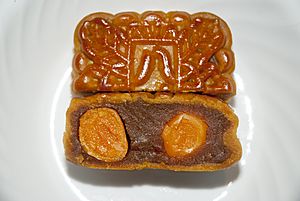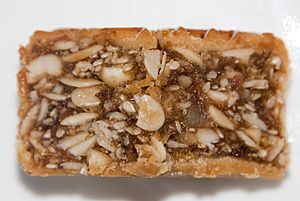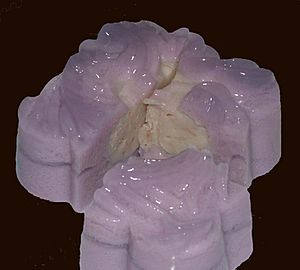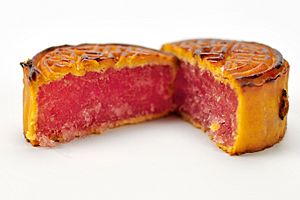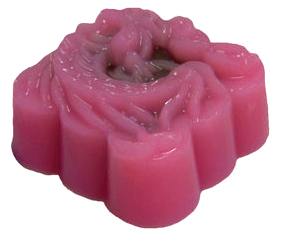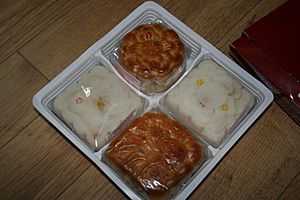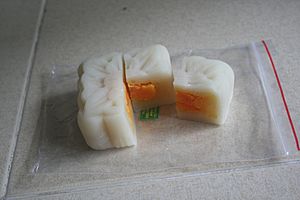Mooncake facts for kids
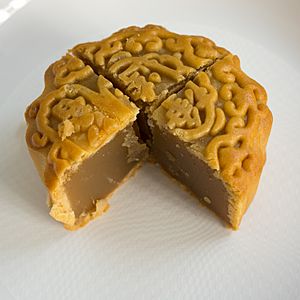
A mooncake filled with lotus seed paste
|
|
| Type | Pastry |
|---|---|
| Course | Dessert |
| Place of origin | China |
| Region or state | East Asia and Southeast Asia |
| Main ingredients | Crust: lard or vegetable oil Filling: red bean or lotus seed paste, salted egg yolk, may or may not have additional ingredients |
| Approximately 416 calories (1,740 kJ) kcal | |
| Mooncake | |||||||||||||||||||||||||||||||||
|---|---|---|---|---|---|---|---|---|---|---|---|---|---|---|---|---|---|---|---|---|---|---|---|---|---|---|---|---|---|---|---|---|---|
| Chinese name | |||||||||||||||||||||||||||||||||
| Traditional Chinese | 月餅 | ||||||||||||||||||||||||||||||||
| Simplified Chinese | 月饼 | ||||||||||||||||||||||||||||||||
| Hanyu Pinyin | yuèbing, yuèbǐng | ||||||||||||||||||||||||||||||||
| Literal meaning | Moon cake/biscuit | ||||||||||||||||||||||||||||||||
|
|||||||||||||||||||||||||||||||||
| Vietnamese name | |||||||||||||||||||||||||||||||||
| Vietnamese alphabet | bánh Trung thu | ||||||||||||||||||||||||||||||||
| Chữ Nôm | 餅中秋 | ||||||||||||||||||||||||||||||||
| Khmer name | |||||||||||||||||||||||||||||||||
| Khmer | នំព្រះច័ន្ទ | ||||||||||||||||||||||||||||||||
A mooncake (simplified Chinese: 月饼; traditional Chinese: 月餅) is a special Chinese pastry. People traditionally eat mooncakes during the Mid-Autumn Festival (中秋節). This festival is all about celebrating the Moon and watching it shine. Mooncakes are seen as a delicious treat. Friends and families share them while celebrating the festival together. The Mid-Autumn Festival is one of China's most important holidays.
There are many kinds of mooncakes eaten in China and by Chinese people living in other countries. The Cantonese mooncake is the most well-known type. A traditional Cantonese mooncake is round, about 10 cm (4 in) wide and 3–4 cm (1.2–1.6 in) thick. It has a rich, thick filling, often made from lotus seed paste. Other common fillings include red bean paste or mixed nuts. A thin crust, about 2–3 mm thick, surrounds the filling. Sometimes, mooncakes also have yolks from salted duck eggs inside.
People usually eat mooncakes in small pieces, often with tea. Today, it's common for businesses and families to give mooncakes as gifts. This has made fancy mooncakes very popular. Mooncakes are enjoyed in many parts of Asia because Chinese communities live there. They have also become a special treat in Western countries.
Contents
What Are Mooncakes Like?
Most mooncakes have a thick, soft pastry skin. This skin wraps around a sweet, dense filling. Some mooncakes have one or more whole salted egg yolks in the middle. These yolks look like the full moon. Sometimes, mooncakes are also steamed or fried, but this is rare.
Traditional mooncakes often have a design pressed on top. This design usually includes Chinese words for "longevity" (long life) or "harmony." The name of the bakery and the filling inside are also often printed. Other decorations might include pictures of the Moon, Lady Chang'e (a mythical Moon Goddess), flowers, vines, or a rabbit. The rabbit is a symbol of the Moon.
Mooncake History
The Mid-Autumn Festival Story
The Mid-Autumn Festival is closely connected to the legends of Chang’e. She is the mythical Moon Goddess of Immortality. An ancient Chinese book called the Liji says that Chinese Emperors would offer gifts to the Sun in spring and the Moon in autumn. The 15th day of the 8th lunar month is called "Mid-Autumn." The night of this day is also known as "Night of the Moon."
Mooncakes have stayed popular because they are so important to the Mid-Autumn Festival. For many people, they are a key part of the festival. This is why the festival is sometimes called the 'Mooncake Festival.'
Mooncakes and the Ming Revolution
There's a famous story about how mooncakes helped overthrow the Yuan dynasty. Messages were secretly hidden inside them. Revolutionaries used mooncakes to help remove the Mongol rulers of the Yuan dynasty. This led to the start of the Ming dynasty.
The idea is said to have come from Zhu Yuanzhang and his advisor Liu Bowen. They spread a rumor that a deadly sickness was spreading. The only way to stop it was to eat special mooncakes. These mooncakes would supposedly make people healthy and give them special powers. This made everyone want to get and eat the mooncakes quickly. But the mooncakes had a secret message: "On the fifteenth day of the eighth lunar month, kill the rulers."
Another way to hide a message was to print it on the surfaces of four mooncakes. This was like a simple puzzle. To read the message, each of the four mooncakes was cut into four pieces. The 16 pieces were then put together to show the secret message. After reading it, the pieces of mooncake were eaten to destroy the message.
Traditional Mooncake Styles
Fillings
Many different fillings can be found in traditional mooncakes:
- Lotus seed paste (蓮蓉, lían róng): Many people think this is the original and most special mooncake filling. It is found in all types of mooncakes. White lotus paste is even more expensive. Sometimes, white kidney bean paste is used instead because lotus paste can be pricey.
- Sweet bean paste (豆沙, dòu shā): Many kinds of bean pastes are used in Chinese desserts. Red bean paste, made from azuki beans, is the most common around the world. But some regions prefer bean paste made from mung beans or black beans.
- Jujube paste (棗泥, zǎo ní): This is a sweet paste made from ripe jujube fruits (also called Chinese dates). The paste is dark red, tastes a little fruity or smoky, and is slightly sour. Sometimes, jujube paste can look like red bean paste, which is sometimes used as a filler.
- Five kernels (五仁, wǔ rén) or mixed nuts: This filling has five types of nuts and seeds, chopped into pieces. They are held together with maltose syrup. The exact nuts and seeds can change by region. Common ones include walnuts, pumpkin seeds, watermelon seeds, peanuts, sesame seeds, or almonds. This mixture also often has candied winter melon, jinhua ham, or pieces of rock sugar for extra flavor.
Crusts
Traditional mooncakes vary a lot depending on where they are made. Most regions make them with many fillings but only one type of crust. While vegetarian mooncakes might use vegetable oil, many mooncakes use lard in their recipes. There are three main types of mooncake crusts in Chinese cuisine:
- Chewy: This crust is reddish-brown and shiny. It is the most common crust for Cantonese-style mooncakes. It is also the type most often seen in North America and Western countries. Chewy mooncake crusts are made with thick sugar syrup, lye water (sodium carbonate), flour, and oil. This gives the crust its rich taste and a chewy but soft texture. Adding more maltose syrup can make it even chewier.
- Flaky: Flaky crusts are common for Suzhou- and Taiwan-style mooncakes. The dough is made by rolling thin layers of oily dough and flour that has been cooked in oil. This crust feels similar to puff pastry.
- Tender: Mooncakes from some parts of China are made to be tender, not flaky or chewy. This crust feels like the shortcrust pastry used in Western pie crusts or tart shells. Tender crusts are mostly a mix of sugar, oil, flour, and water. This type of crust is also used in other Chinese pastries, like the egg tart.
- Crumbly: Yunnan-style mooncakes use a special hot water crust pastry. This dough mixes different kinds of flour with oil, salt, and hot water. It creates a dense, crumbly pastry that is quite unique.
Regional Mooncake Styles in China
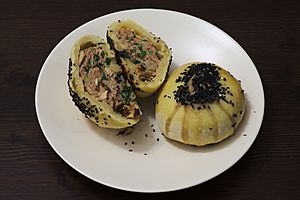
There are many different types of mooncakes based on the region where they are made:
- Beijing-style mooncake: This style has two main types. One is called di qiang and has a light, foamy dough, like Suzhou-style mooncakes. The other, called "fan mao", has a flaky, white dough. Popular fillings include mountain hawthorn and wisteria blossom flavors.
- Cantonese-style mooncake: These mooncakes come from Guangdong and Guangxi provinces. They have many different fillings like lotus seed paste, melon seed paste, nuts, ham, chicken, duck, roast pork, mushrooms, and egg yolks. Some fancy versions have four egg yolks, which stand for the four phases of the moon. In Hong Kong, you can even find modern versions made from chocolate, ice cream, or jelly.
- Shanghai-style mooncake: This style uses a rich, crumbly, and buttery shortcrust pastry, similar to pie dough. Popular fillings are sweet, like sweetened red bean paste, lotus seed paste, and taro paste, often with egg yolks in the middle.
- Hong Kong-style mooncake: Hong Kong has developed its own mooncake styles. While people there often eat Cantonese-style mooncakes, new types like snow skin mooncakes have become popular in recent decades.
- Chaoshan-style mooncake: This is another type with a flaky crust, but it's larger than the Suzhou variety. It's similar in width to the Cantonese style but thinner. Many fillings are used, and the smell of lard after baking is important. The Chaozhou people also have a fried lotus cake (simplified Chinese: 莲花酥月饼; traditional Chinese: 蓮花酥月餅; pinyin: Liánhuā sū yuèbǐng), eaten during the Mid-Autumn Festival. This mooncake is deep-fried, not baked. Yam filling and a flaky pastry crust make Teochew mooncakes special. These old-style treats are called la bia in the Chaoshan region, where the Teochews are from. La means lard or pork oil in Teochew, which is mixed with flour to make the pastry.
- Ningbo-style mooncake: This style is also inspired by the Suzhou-style. It is common in Zhejiang province and has a firm outer layer. The fillings can be seaweed or ham. It is also known for its spicy and salty taste.
- Suzhou-style mooncake: This style is over a thousand years old. It is known for its many layers of flaky dough and lots of sugar and lard. There are more than a dozen different kinds within this style. They are also smaller than most other regional types. Suzhou-style mooncakes can be sweet or savory. The savory ones are often served hot and filled with minced pork. Fillings made from salt and pepper (椒盐, jiāoyán) are common in flaky Suzhou-style mooncakes.
- Yunnan-style mooncake: The special thing about this mooncake is that its dough uses different flours, including rice flour, wheat flour, and buckwheat flour. The filling mixes Xuanwei ham and sugar.
Modern Mooncake Styles
Over time, mooncakes have changed a lot. Both the crusts and the fillings have become more varied. This happened because companies wanted to sell more mooncakes and because people's tastes changed. Also, people are more interested in healthy eating now. So, many of these modern styles are popular with younger Chinese people and those living outside China. However, traditional mooncakes are still sold alongside the new ones.
Some of the first changes were using unusual fillings. Taro paste (芋泥, yù ní), pineapple, and durian were among the first new flavors. These were especially popular with Chinese communities in Southeast Asia. The crust also changed, with the introduction of "snow skin mooncakes." Unlike traditional mooncakes, snow skin mooncakes are not baked and need to be kept in a refrigerator. They are white on the outside. Even though white traditionally means something sad in China (like wearing white to a funeral), this type of white mooncake is popular with teenagers. Smaller mooncakes also appeared, making them easier to eat without cutting.
To fit today's healthy lifestyles, fat-free mooncakes have also appeared. Some are made of yogurt, jelly, and fat-free ice cream. Customers can choose the size and filling that fits their taste and diet. For better hygiene, each cake is often wrapped in airtight plastic with a tiny packet to keep it fresh.
Modern mooncakes are popular, but some people don't like them. Expensive ingredients have made prices go up, causing worries about a "mooncake bubble" in China. Some food critics say that "chocolate mooncakes" are just chocolate shaped like mooncakes, not actual mooncakes made of chocolate. Others complain that food companies just want to create strange flavors to make money, without thinking if the tastes actually go well together.
Fillings
Modern mooncake fillings have become very diverse. They now include almost anything that can be made into a paste. Mooncakes with taro paste and pineapple, once new and exciting, are now common. Also, fillings with ingredients like coffee, chocolate, nuts (walnuts, mixed nuts, etc.), fruits (prunes, pineapples, melons, lychees, etc.), vegetables (sweet potatoes, etc.), and even ham have been added. These give a modern twist to traditional recipes.
Some other examples include:
- cream cheese
- chicken floss
- tiramisu
- green tea
- pandan
- purple yam
- durian
- ice cream (many flavors)
- chocolate
- strawberry
- coffee
- peanut
- mango pomelo sago
- mala
- lava custard
Traditional Chinese treats like ginseng and bird's nest were soon followed by abalone and shark fin. Foreign food companies have also joined in. Häagen-Dazs was one of the first to make an ice-cream mooncake. You could choose between "traditional," snow-skin, or Belgian/Swiss white, milk, and dark chocolate crusts. Other ice-cream and restaurant chains quickly made their own versions. Other Western ingredients, like champagne ganache, malt whisky, volcanic-salt caramel, and even black truffles, caviar, and foie gras, have also found their way into mooncakes.
Crusts
Snowy mooncakes first appeared in the early 1980s. These mooncakes are not baked and are served chilled. They usually have two types of crusts:
- Glutinous rice: This crust feels like mochi. This is what a snow skin mooncake is made of. These mooncakes are also called "ice-skin mooncakes" or "snowy mooncakes" (冰皮 or 冰皮月餅).
- Jelly: This crust is made from gelling mixtures like agar, gelatin, or konjac. It is flavored with many different fruit flavors.
Mooncakes in Other Countries
Malaysia
Three main cities in Malaysia have many types of mooncakes: George Town, Kuala Lumpur, and Sabah. Their mooncakes are quite similar to traditional Chinese ones. However, many people prefer to add pure Hunan lotus seeds to keep the mooncake quality high. The most popular types, especially in Kuala Lumpur, are White Lotus Seed Paste Cake, Snow Skins, and Black Sesame With Yolk.
Indonesia
In Indonesia, there are several types of mooncakes, from traditional to modern. Very traditional mooncakes have been around since Chinese and Japanese people came to Indonesia. They are round like the moon, white, and thinner than regular mooncakes. Fillings can include pork, chocolate, cheese, milk, durian, jackfruit, and many other exotic fruits made into a paste. These traditional mooncakes are sold all year. Modern mooncakes are usually only sold around the Mid-Autumn Festival.
Japan
Mooncakes in Japan are called geppei (geppei (月餅)). This name sounds like the Chinese name. Japanese mooncakes look like Cantonese mooncakes. They are linked to Chinese culture and are sold all year, mainly in Japan's Chinatowns. Azuki (red bean) paste is the most popular filling. But other types of beans and chestnut are also used.
Vietnam
In Vietnam, mooncakes are called bánh trung thu, which means "mid-autumn cake." Vietnamese mooncakes are usually sold one by one or in a set of four. There are two kinds: bánh nướng (baked mooncake) and bánh dẻo (sticky rice mooncake).
Bánh nướng and bánh dẻo are special cakes in Vietnam. They are very popular and are only sold during the Mid-Autumn Festival. Vietnamese mooncakes are often round (about 10 cm wide) or square (about 7–8 cm long). They are usually 4–5 cm thick, but larger sizes can be found. Their designs are similar to Cantonese mooncakes. However, you might also see pictures of a sow with her cub, fish, or shrimp.
Vietnamese mooncakes have two main parts: the crust and the filling. The ingredients often include jam, dried sausage, mung bean paste, salt, sugar, cooking oil, sugared lard, lotus seeds, and watermelon seeds. Vietnamese mooncakes are usually sweeter than other types. To balance this, a salted egg yolk is often added. They can be baked or eaten right away.
Bánh nướng (baked mooncake) is made from wheat flour, cooking oil, and simple syrup boiled with malt. After being filled with things like salted egg yolk, dried sausage, mung bean paste, and sugared pig fat, it is brushed with egg wash. Then it's baked in the oven. The egg wash keeps the crust from drying out and gives the cake a nice smell. The cakes must be turned often in the oven to prevent burning.
Bánh dẻo (sticky rice mooncake) is easier to make than bánh nướng. Both the crust and filling are pre-cooked. The crust is made from roasted glutinous rice flour, pomelo blossom water or vanilla, and simple syrup. After mixing the rice flour, fillings similar to those in baked mooncakes are put inside the crust. Then the cake is placed into a mold dusted with a thin layer of flour to prevent sticking. This cake can be eaten right away without any more steps. Bánh dẻo is not as popular as bánh nướng.
Taiwan
The most traditional mooncake in Taiwan looks like those from southern Fujian. Taiwanese mooncakes are filled with sweetened red bean paste, sometimes with mochi in the center. The most common traditional mooncakes from Taiwan have mung bean (lu dou) or taro paste fillings. Mung bean mooncakes usually have a salted duck egg yolk. Taro mooncakes might have a salted duck egg or a savory treat. They usually have a flaky crust and are round. Instead of a pressed pattern like Cantonese versions, Taiwanese mooncakes often have a red stamp, usually a Chinese character for celebration. Modern Taiwanese mooncakes come in many varieties, including low-fat, lard-free, and ice cream versions. Popular modern flavors include green tea, chocolate, strawberry, and tiramisu.
Thailand
In Thailand, mooncakes (in Thai, ขนมไหว้พระจันทร์) are sold in Thai-Chinese bakeries during the festival season. In Bangkok, you can find traditional and modern mooncakes not only in Chinatown on Yaowarat Road but also in stalls at large supermarkets.
Singapore
In Singapore, mooncakes are seen as fancy gifts. They come in many flavors, from traditional baked ones to flaky Teochew ones with yam paste, and chilled snowskin varieties with fruit pastes. Traditional mooncakes have basic fillings like red lotus paste, white lotus paste, or red bean paste. They often have 0-4 salted duck egg yolks inside. Some variations add other ingredients like macadamia nuts, osmanthus, orange peel, and melon seeds.
Snowskin mooncakes in Singapore have flavors like Lychee Martini, Baileys, Matcha Red Bean, durian, and various fruit pastes.
Mooncakes are popular luxury gifts in Singapore for clients, friends, and family. A box of four mooncakes costs about US$60. Many hotels and fancy Chinese restaurants offer mooncakes in beautiful boxes with many sections and jeweled clasps. After the festival, these mooncake boxes are often reused as jewelry boxes.
Images for kids
See also
 In Spanish: Pastel de luna para niños
In Spanish: Pastel de luna para niños


